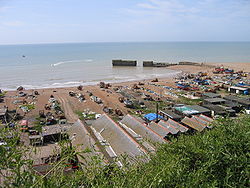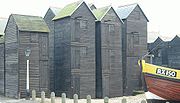
The Stade
Encyclopedia

Shingle beach
A shingle beach is a beach which is armoured with pebbles or small- to medium-sized cobbles. Typically, the stone composition may grade from characteristic sizes ranging from two to 200 mm diameter....
, situated in Hastings Old Town
Hastings Old Town
Hastings Old Town is an area in Hastings roughly corresponding to the extent of the town prior to the nineteenth century. It lies mainly within the eastern-most valley of the current town...
. It has been used for beaching boats for over a thousand years, a use which continues to this day: it is now home to Europe's largest fleet of beach-launched fishing boats.
The word ‘Stade’ is an old Saxon term meaning "landing place", and dates from before the Battle of Hastings
Battle of Hastings
The Battle of Hastings occurred on 14 October 1066 during the Norman conquest of England, between the Norman-French army of Duke William II of Normandy and the English army under King Harold II...
in 1066.
It was originally a small landing area, hence the small footprint of the net shops. However, the building of the 1887 groyne
Groyne
A groyne is a rigid hydraulic structure built from an ocean shore or from a bank that interrupts water flow and limits the movement of sediment. In the ocean, groynes create beaches, or avoid having them washed away by longshore drift. In a river, groynes prevent erosion and ice-jamming, which...
at Rock-A-Nore
Rock-a-Nore
Rock-a-Nore is an urban area of Hastings, stretching from the Old Town area along Rock-a-Nore Road between the cliffs and the beach...
and the 1896 harbour stopped the eastward longshore transport of shingle along the coast, which is the function of groynes. As a result, the Stade steadily grew out to seaward, providing new room for the fishing fleet and many amenities.
Present day fishing

Europe
Europe is, by convention, one of the world's seven continents. Comprising the westernmost peninsula of Eurasia, Europe is generally 'divided' from Asia to its east by the watershed divides of the Ural and Caucasus Mountains, the Ural River, the Caspian and Black Seas, and the waterways connecting...
's biggest fleet of beach-launched fishing boats. The boats have to be hauled out of the sea after each trip, which stops them being more than about ten metres long. This means that they can only carry small amounts of gear and travel just a few miles. As a result the fleet has always fished in an ecologically sound way.
The Stade has today a vibrant working community that enjoys great traditions for many generations. It also represent the perfect combination of a historically protected area being ecologically utilized by a contemporary working force. In fact, there are not many places in the world today such as the Stade, where one can find a driving community working in a protected area of great historical relevance, one that still keeps its original look, its old traditions, standards and original atmosphere.
Net Shops

The sheds were originally built on posts to allow the sea to go underneath, however more shingle has built up and the sea does not reach the huts anymore. The beach area, on which the Sheds stand, built up after groynes were erected in 1834, however the limited space meant the sheds had to grow upwards, even though some sheds do have cellars.
A common misconception is that the sheds were used for drying the nets, hence the height. This is incorrect: nets were dried on the beach, and the sheds were built for net storage – the height is due to the limited space, and inside the sheds have always had multiple floors.

